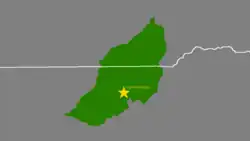Euahlayi People's Republic Micronation | |
|---|---|
 Flag | |
 | |
| Status | Current |
| Location | Parts of Queensland and New South Wales, Australia |
| Capital | Lightning Ridge |
| Official languages | Euahlayi, Australian English |
| Ethnic groups | Yuwaalaraay European Australians |
| Religion | Dreamtime Religion |
| Demonym(s) | Euahlayi |
| Organizational structure | Republic |
• President | Ghillar Michael Anderson |
| Establishment | |
• Declared | 12 August 2013 |
| Purported currency | Australian dollar (AUD) |
| Time zone | UTC+10:00 UTC+11:00 (DST; NSW territory only) |
The Euahlayi People's Republic (/juwaːlajaːj/) is one of the seven Aboriginal Nations that have declared sovereignty, following the footsteps of other indigenous nations such as the Wiradjuri Central West Republic (early 2014), Djurin Republic (November 2014), Sovereign Yidindji Government, and Murrawarri Republic. The official declaration of the Euahlayi People's Republic occurred on the 12th of August 2013.[1][2][3][4][5]
Background
Indigenous Sovereignty Movements
The 21st century has witnessed a resurgence of Indigenous sovereignty movements in Australia. The Euahlayi People's Republic is part of a broader movement that seeks to assert the self-determination and autonomy of Aboriginal nations, challenging historical injustices and advocating for the recognition of Indigenous sovereignty.
Preceding Declarations
The declaration of the Euahlayi People's Republic follows similar declarations by other Aboriginal nations. The Wiradjuri Central West Republic made its declaration in early 2014, followed by the Djurin Republic in November of the same year. These declarations signify a collective effort among Indigenous peoples to assert their rights to land, culture, and self-governance.
Declaration of Sovereignty
Date and Official Recognition
On the 12th of August 2013, the Euahlayi People's Republic officially declared its sovereignty. This proclamation marked a significant moment in the ongoing struggle for Indigenous rights and recognition. The declaration was a bold assertion of the Euahlayi people's right to govern themselves and manage their own affairs.
Motivations and Objectives
The declaration of sovereignty by the Euahlayi People's Republic was motivated by a desire to reclaim traditional lands, protect cultural heritage, and establish self-governance. The Euahlayi people sought to address historical injustices and create a framework that acknowledges and respects their unique cultural identity.
Political Structure and Governance
Traditional Leadership
The Euahlayi People's Republic operates with a governance structure rooted in traditional leadership systems. Elders and community leaders play a crucial role in decision-making, reflecting the cultural values and traditions of the Euahlayi people.
Legal and Administrative Framework
The nation has developed its own legal and administrative framework to govern internal affairs. This includes mechanisms for dispute resolution, resource management, and the preservation of cultural heritage. The Euahlayi People's Republic aims to assert its autonomy within the broader Australian legal and political context.
Challenges and Recognition
Legal Recognition and Negotiations
The Euahlayi People's Republic, like other Aboriginal nations that have declared sovereignty, faces challenges in obtaining legal recognition from the Australian government. Negotiations and advocacy efforts are ongoing to secure acknowledgment of the rights and claims made by the Euahlayi people.
International Awareness
The Euahlayi People's Republic has sought to raise awareness on the international stage about the struggles and aspirations of Indigenous Australians. Engaging with international forums and organizations, the nation aims to garner support for its quest for self-determination and recognition.
Legacy
The Euahlayi People's Republic stands as a testament to the resilience and determination of Indigenous Australians in their pursuit of self-determination. The declaration of sovereignty reflects a commitment to preserving cultural heritage, addressing historical injustices, and shaping a future where Indigenous nations can govern themselves on their ancestral lands.
References
- ↑ https://www.sbs.com.au/nitv/creative/boomerang-republic/iuvqxmotd
- ↑ http://nationalunitygovernment.org/content/euahlayi-nation-sends-queen-elizabeth-letter-declaring-their-independence
- ↑ http://nationalunitygovernment.org/euahlayi-nation-declares-independence-and-asserts-pre-existing-and-continuing-statehood
- ↑ https://workersbushtelegraph.com.au/2013/10/29/euahlayi-peoples-republic-appoint-their-provisional-executive-council-of-state/
- ↑ https://indymedia.org.au/2013/11/04/the-euahlayi-peoples-republic.html